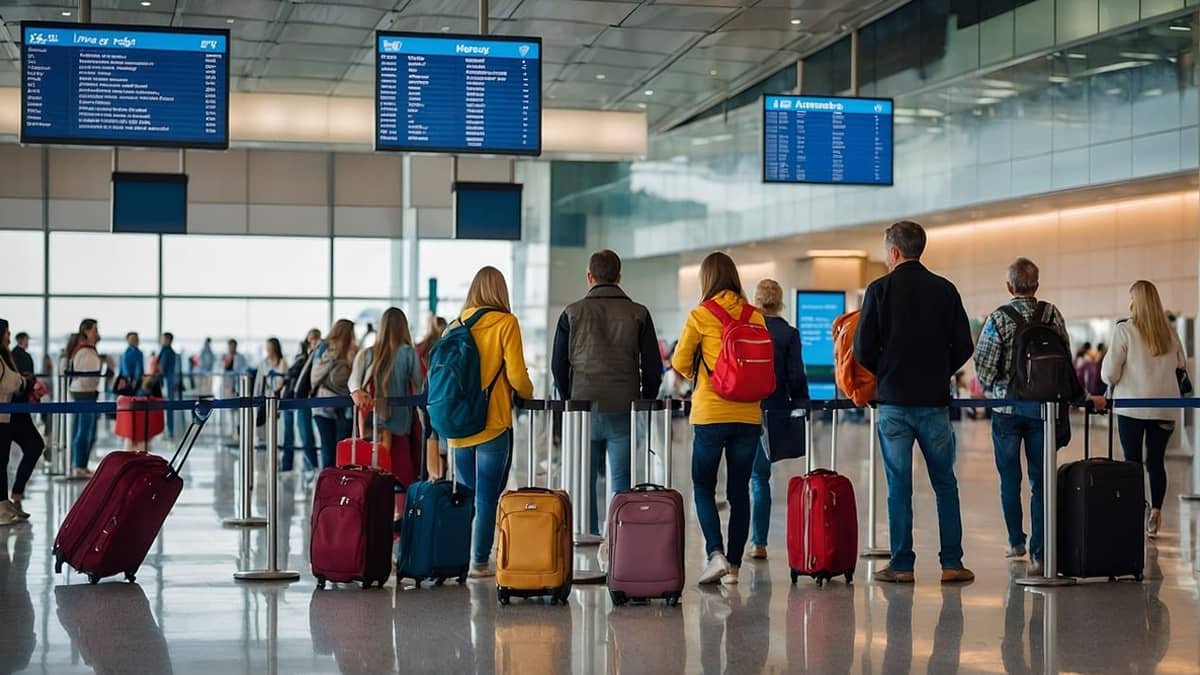Top 10 Busiest Airport in India

India’s aviation sector has witnessed remarkable growth in recent years, with airports across the country experiencing significant increases in passenger traffic. As of the fiscal year 2023–24, several airports have emerged as major hubs, reflecting the nation’s expanding connectivity and economic development. This surge is fueled by investments in infrastructure, modernization of terminals, and the growth of low-cost carriers. Here is an overview of the top 10 busiest airports in India based on passenger traffic:
1. Indira Gandhi International Airport (DEL), Delhi
- Passengers (2023–24): 73.67 million
- Growth: 12.8% increase from the previous year
Indira Gandhi International Airport in Delhi remains the busiest airport in India, serving as a vital hub for both domestic and international travel. Strategically located in the nation’s capital, it connects major global and Indian cities, handling millions of passengers annually. Its modern infrastructure, efficient operations, and continuous expansion reflect its crucial role in India’s aviation sector. With steady growth year after year, the airport plays a key role in supporting tourism, business travel, and international connectivity across the country.
2. Chhatrapati Shivaji Maharaj International Airport (BOM), Mumbai
- Passengers (2023–24): 52.82 million
- Growth: 20.2% increase from the previous year
Located in Mumbai, Chhatrapati Shivaji Maharaj International Airport is the second busiest in India. Its prime location makes it a key aviation hub for Western India, handling extensive domestic and international traffic. The airport’s importance continues to grow, supported by ongoing infrastructure upgrades and service improvements. Additionally, the development of Navi Mumbai International Airport is set to alleviate congestion and further boost regional connectivity, making Mumbai a pivotal gateway for both business and leisure travelers in the years ahead.
3. Kempegowda International Airport (BLR), Bengaluru
- Passengers (2023–24): 37.53 million
- Growth: 17.6% increase from the previous year
Kempegowda International Airport, serving the tech hub of Bengaluru, is renowned for its operational efficiency and focus on sustainability. The recent launch of Terminal 2, famously called the “Terminal in a Garden,” has significantly boosted the airport’s capacity while offering a world-class travel experience. With lush green spaces and eco-friendly design, the terminal reflects Bengaluru’s identity as the Garden City. This expansion positions the airport as a major gateway for both domestic and international travelers in Southern India.
4. Rajiv Gandhi International Airport (HYD), Hyderabad
- Passengers (2023–24): 25.04 million
- Growth: 19.3% increase from the previous year
Rajiv Gandhi International Airport in Hyderabad is widely recognized for its exceptional passenger satisfaction and top-tier services. Strategically positioned in South-Central India, it plays a vital role in connecting key domestic and international destinations. With ongoing expansion efforts, including the construction of a new terminal, the airport is set to double its capacity. These developments aim to accommodate growing traffic demands and enhance the overall travel experience, reinforcing its reputation as one of India’s leading and fastest-growing aviation hubs.
5. Chennai International Airport (MAA), Chennai
- Passengers (2023–24): 21.21 million
- Growth: 14.2% increase from the previous year
Chennai International Airport, Tamil Nadu’s primary aviation hub, is undergoing significant expansion to meet rising passenger demand. The ongoing Phase 2 development includes Terminal 3, which will boost the airport’s annual capacity to 35 million passengers by early 2026 . Recent enhancements, such as new terminals and upgraded facilities, have already increased domestic capacity to 16 million passengers annually .

6. Netaji Subhas Chandra Bose International Airport (CCU), Kolkata
- Passengers (2023–24): 19.78 million
- Growth: 11.3% increase from the previous year
Netaji Subhas Chandra Bose International Airport in Kolkata serves as a crucial hub for Eastern India, connecting both domestic and international travelers. In the 2024–25 fiscal year, the airport handled over 21.5 million passengers, nearing its pre-pandemic peak. Ongoing expansion projects, including a ₹5,000 crore plan to increase capacity to 33 million passengers annually, aim to accommodate growing demand. These developments underscore the airport’s strategic importance and its role in supporting regional connectivity and economic growth.
7. Sardar Vallabhbhai Patel International Airport (AMD), Ahmedabad
- Passengers (2023–24): 11.70 million
- Growth: 15.4% increase from the previous year
Sardar Vallabhbhai Patel International Airport in Ahmedabad, Gujarat, serves the twin cities of Ahmedabad and Gandhinagar. As Gujarat’s busiest airport, it handled over 11.70 million passengers, The airport is a focus city for Air India and an operating base for IndiGo, reflecting its significance in regional connectivity. To accommodate growing demand, expansion plans aim to boost annual capacity from 8 to 20 million passengers by 2025–26 .
8. Cochin International Airport (COK), Kochi
- Passengers (2023–24): 10.37 million
- Growth: 17.6% increase from the previous year
Cochin International Airport (COK), located in Kerala, India, is renowned as the world’s first fully solar-powered airport. In 2015, it achieved this milestone by installing over 46,000 solar panels across 45 acres, generating approximately 50,000 to 60,000 units of electricity daily, making the airport “absolutely power neutral” . This initiative not only underscores its commitment to sustainable development but also sets a precedent in renewable energy utilization within the aviation sector.
9. Pune International Airport (PNQ), Pune
- Passengers (2023–24): 9.53 million
- Growth: 10.66% increase from the previous year
Pune Airport experienced significant growth in FY 2024–25, handling over 9.53 million passengers—a 10.66% year-on-year increase—driven by the city’s expanding IT and manufacturing sectors . To further enhance regional connectivity, the proposed Chhatrapati Sambhaji Maharaj International Airport in Purandar is planned with a capacity of 75 million passengers per annum, featuring two parallel 4,000-meter runways and a dedicated cargo terminal . Land acquisition for the 2,832-hectare project is underway, aiming to bolster Pune’s infrastructure and economic growth .
10. Dabolim Airport (GOI), Goa
- Passengers (2023–24): 6.87 million
- Growth: 17.8% decrease from the previous year
Serving the popular tourist destination of Goa, Dabolim Airport has experienced a decline in passenger traffic, partly due to the opening of the new Manohar International Airport, which has started to share the region’s air traffic load. While Dabolim continues to operate primarily domestic and charter flights, Manohar International Airport is rapidly expanding its operations and attracting more airlines. This shift in traffic distribution is reshaping Goa’s aviation landscape, providing improved connectivity while easing congestion at the older Dabolim facility.
Conclusion
India’s aviation industry is poised for continued growth, fueled by substantial investments in infrastructure and the development of new airports. The government’s regional connectivity schemes and public-private partnerships are driving progress across urban and rural areas alike.
Major projects like the Navi Mumbai International Airport, along with expansions at Delhi, Bengaluru, and Hyderabad airports, are set to significantly boost capacity. These developments not only improve passenger convenience and air cargo efficiency but also play a vital role in supporting India’s broader economic growth and global integration.
1st Image Credit- Indira Gandhi International Airport








